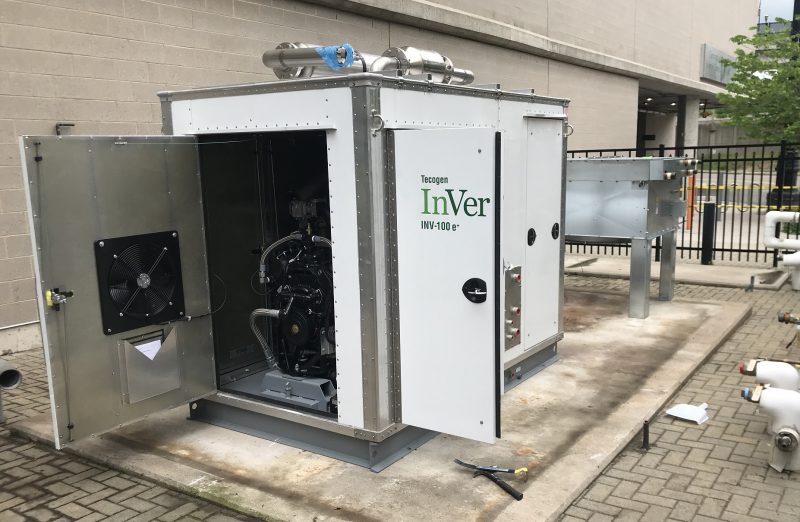With its Green Mission and eye toward innovation, the Science Center “didn’t just stop with the LEED certification” awarded in 2010, says Cherie Sweeney, Vice President of Operations.
As technology advances, creating opportunities for energy savings, there are adjustments to make — like changing light bulbs.
Multiple different types of inefficient light fixtures were retrofitted with low-energy LED bulbs in phases. This shift was made possible through the Neighborhood Assistance Act (NAA) Tax Credit Program.

Installation of the new cogen system
The hydrogen fuel cell that was operating here for five years was another swap that the Science Center made. Cherie explained that fuel cells have a shelf life of 5-10 years before a major overhaul is required, and ours was no exception. Because affordable fuel cell technology has not progressed like we thought it would, we replaced it with a cogeneration system that runs on natural gas. Cherie describes it as a “giant engine” (about the size of a tractor-trailer truck engine) in which electricity is produced and the heat from its internal combustion engine is captured. This is used to preheat the building’s hot water closed loop heating system and domestic hot water system.
In 2014, as part of the Connecticut Retro-Commissioning Program, consultants came to see if we were as energy efficient as we could be, Cherie says. Their Survey Report presented a broad assessment of the building’s major energy-consuming equipment and systems. Based on their report the Science Center made a few adjustments. For example, the entire building was observed to be under negative pressure. The excessive exhaust flow rates from the atrium exhaust fans was suspected to be responsible for the building pressurization imbalance. By balancing exhaust flow, the space pressurization was adjusted to near design conditions thereby eliminating excessive infiltration and loss of conditioned air. In other words, there was a ‘chimney effect’ — conditioned air (heated or cooled) was excessively drawn out of the building by six jumbo jet engine-sized exhaust fans on the south tower roof.
An example of other adjustments that were made beyond retro-commissioning was on Mondays when the building is closed to the public, the escalator would keep running. Turning it off has been one change. For special occasions, like holidays when the Science Center is open, it can be turned back on.
Another thing we no longer do is line trash cans with plastic trash bags, now opting for biodegradable ones instead.
“We only use green cleaning products for standard day-to-day maintenance,” Cherie says. Other products may be used for special circumstances, but those are not deployed casually.
After realizing how many paper towels were being used, the dispensers were removed from many of the bathrooms around the building. Several high air velocity hand dryers were added. As a compromise, some paper towel dispensers remain in the family restrooms.
Our partners have also been upgrading their practices. J. René Coffee Roasters switched to paper straws in 2019 and Subway is in the process of doing this. Subway has stopped using plastic bags, and our gift shop ditched plastic bags before it was cool! Event Network, the gift shop operator, is stocking stainless steel straws, mugs, and reusable water bottles, along with reusable bags. Riverhouse, the Science Center’s new caterer, provides local, seasonal menus and green catering.
Ten years in, the Connecticut Science Center remains particularly interested in the energy performance of its building and is motivated to operate it in a sustainable manner and thereby reduce electrical demand, energy usage and water.

Kerri Provost is a Communications Research Associate at the Connecticut Science Center who is outdoors whenever possible and is currently attempting to walk every block of Hartford. She is the co-producer of Going/Steady, a podcast about exploring in the Land of Steady Habits and beyond.


